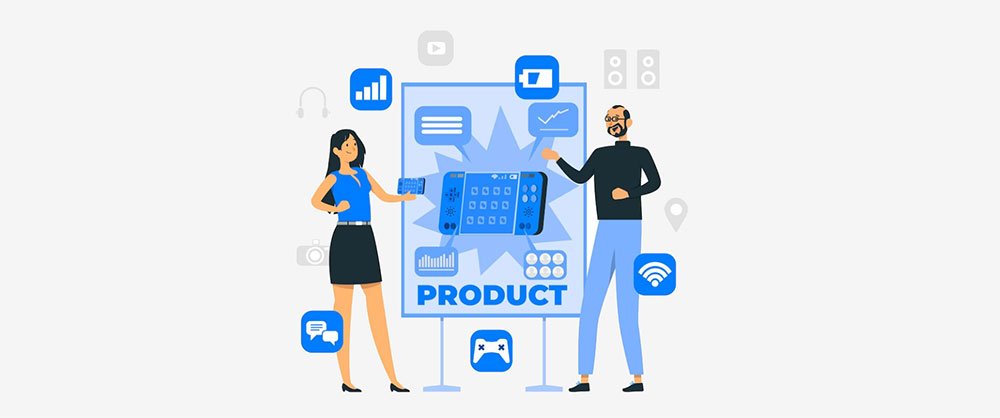Driving Growth through Lean Product Development

Picture this. You’ve got an innovative product idea simmering in your mind’s cauldron.
But here’s the rub: how do you take this fledgling concept and catapult it into a market hit without the excess fat of traditional development dragging it down?
Enter the realm of lean product development. A philosophy trimmed of the unnecessary, tailoring each design sprint to the rhythm of customer pulses.
We’re not just spinning a tale of hypothetical success stories; we’re walking the walk of the agile, the efficient, the daringly frugal.
Together, we’ll journey through the core of lean principles, pluck out the value-packed strategies from the Toyota Production System, and learn how to craft a physics-defying Minimum Viable Product (MVP) that soars above competition.
Expect to unravel:
- How continuous improvement can be your product’s lifeblood,
- The art of eliminating waste in your process to streamline creativity,
- Iterative design techniques that respond rapidly to user demands.
By the article’s end, you’ll be equipped to transform your vision into a tangible asset with less bulk and more value – a true lean product masterpiece.
Key takeaways
- Efficiency and Customer Value: LPD is a philosophy focused on efficiency and delivering maximum customer value while minimizing waste. It’s considered a standard for modern, innovative product management, especially in fast-paced industries.
- Lean Principles Across Industries: Originally a manufacturing approach exemplified by Toyota’s Production System, Lean principles have successfully transitioned to product development, emphasizing waste minimization and customer value across all industries.
- Defining Value and Streamlining Process: A fundamental step in LPD is defining customer value as the guiding star for the development process. Identifying and eliminating wasteful steps in the value stream is crucial to achieve a lean, efficient process.
- Empowerment and Continuous Improvement: Lean stresses the importance of team empowerment, providing autonomy and resources needed for success. Additionally, it advocates for a continuous learning and improvement mindset to keep evolving and enhancing product development practices.
The History and Evolution of Lean
It’s fascinating to see how a concept like Lean, born in the factory floors, found its way into the digital domain. Let’s go back in time, shall we?
Origin of Lean in Manufacturing
Once upon a time, Lean was all about manufacturing. Specifically, it was about making manufacturing processes more efficient, less wasteful, and overall, just better. This was the era of mass production, where factories were king. And in this setting, Lean proved to be an absolute game-changer.
The goal was simple: make more using less. Less time, less resources, less space – anything that didn’t add value to the final product was minimized. This mindset changed the game, resulting in efficient, lean, and mean production machines.
Transition of Lean from Manufacturing to Product Development
But, the world of factories and assembly lines is a far cry from the creative chaos of product development. So, how did Lean make the leap? It’s about principles, not the setting.
The same principles that minimized waste and maximized value in factories were adapted to the world of product development. The goal remained the same: maximize customer value and minimize waste.
Influence of Toyota’s Production System on Lean Development
You can’t talk about Lean without mentioning the Toyota Production System. Toyota took the principles of Lean and built a car-making empire. The Toyota Production System is a testament to the power of Lean. It’s an approach that eliminates waste, optimizes efficiency, and constantly seeks improvement – all in the service of creating more value for the customer.
The influence of Toyota’s production system on Lean development is profound. It’s about instilling a culture of continuous improvement, optimizing the whole process and not just individual parts, and always, always, putting the customer first.
In a way, this mindset has become an essential part of the product manager career path. It’s about constantly learning, improving, and striving to deliver maximum value.
Principles of Lean Product Development

Alright, let’s get into the meat and potatoes of Lean Product Development. What makes it tick? Here are the guiding principles:
Define and Maximize Customer Value
In my line of work, the customer is king. It’s not just about what you think is valuable; it’s about what they perceive as valuable. Your product should solve a problem they have or make their lives better in some way.
As a product manager, the first step on your Lean journey is to define what value means to your customer. It’s like the North Star guiding your entire product development process. Every feature, every function, every design decision should aim to maximize this value.
Identify the Value Stream and Eliminate Waste
Once you’ve identified customer value, the next step is to chart the path to creating it – this is your value stream. It’s all the steps, processes, and resources that go into creating and delivering your product.
But here’s the kicker, not all steps in this stream create value. Some are wasteful and inefficient. Lean says, “identify and eliminate these wasteful steps.” The goal is a value stream that’s efficient and lean, just like a well-oiled machine.
Make the Value-Creating Steps Flow
Creating a product is like a relay race. Every step, every process is a runner, passing the baton to the next. You want this race to be smooth, without any hiccups or roadblocks. This is where the principle of ‘flow’ comes in.
In Lean, you organize your value stream in such a way that each value-creating step seamlessly flows into the next. No bottlenecks, no delays, just smooth and efficient flow.
Empower the Team
No one can whistle a symphony. It takes an orchestra to play it. Product development is a team sport, and Lean acknowledges this. It emphasizes the importance of empowering the team, giving them the autonomy, the resources, and the support they need to do their best work.
Learn and Improve
The last principle of Lean Product Development is perhaps the most important. It’s about cultivating a mindset of continuous learning and improvement. You’ve got to be like a shark, always moving, always improving. This principle keeps you on a product manager career path that’s dynamic and constantly evolving.
Lean Product Development Practices
Alright, so we know the principles. But how do you put them into practice? Here’s how:
First Principle: Define Value to the Customer
Voice of the Customer Research
You can’t deliver value if you don’t know what your customer values. And the best way to find this out? Just ask them! Voice of the Customer (VoC) research is all about listening to your customers, understanding their needs, their problems, and their expectations. It’s like a compass guiding your product development efforts.
Quality Function Deployment
Quality Function Deployment (QFD) is like the blueprint of your customer value. It translates customer needs into specific product requirements, ensuring that your product is designed to deliver maximum value.
Lean Design
Lean design is all about designing products that deliver maximum value with minimum waste. It’s not just about aesthetics, it’s about functionality, usability, and value.
Platforms and Design Re-Use
Why reinvent the wheel when you can reuse and adapt existing designs? Platforms and design re-use allow you to leverage previous design efforts, reducing waste and speeding up the development process.
Rapidly Explore Alternatives
The world of product development is full of choices. Lean encourages you to rapidly explore these alternatives, iterate, and experiment to find the most value-adding, efficient solution.
Second Principle: Identify the Value Stream and Reduce Waste
Streamline the Development Process
Efficiency is the name of the game here. You’re looking to build a sleek, high-speed train, not a clunky, slow-moving one.
You need to streamline your development process, making sure it’s optimized for speed and quality.
5S Workplace
5S stands for Sort, Set in order, Shine, Standardize, and Sustain. It’s all about organizing your workplace in a way that boosts productivity and minimizes waste.
For a product manager, this could mean anything from organizing your digital files to streamlining communication channels.
Standardized Work
Standardized work is about consistency. It’s about doing things the same way, every time, to ensure quality and minimize mistakes.
It’s not about stifling creativity, it’s about creating a reliable base that allows creativity to flourish.
Integration of Design Tools
There are a ton of awesome design tools out there. But, if they’re not integrated, you’re missing out. Integrated design tools allow for smoother collaboration, faster iterations, and an overall more efficient design process.
Third Principle: Make the Value-Creating Steps Flow
Pipeline Management
In Lean, your product development process is your pipeline. And just like a real pipeline, you want the value to flow smoothly, without any leaks or blockages.
Pipeline management is all about ensuring this smooth, continuous flow of value.
Flow Process and Pull Scheduling
Flow process is about arranging your value-creating steps in a logical, efficient sequence. Pull scheduling, on the other hand, is about letting the demand pull the process, not the other way around. It’s about making sure you’re working on what’s needed, when it’s needed.
Reduce Batch Sizes
Big batches mean big risks. If something goes wrong, the whole batch could be affected. By reducing batch sizes, you minimize risk and increase flexibility.
Synchronize Activities
Product development is a symphony, and you’re the conductor. You need to synchronize all the activities, ensuring they’re all playing the same tune at the same time.
Defer Commitment
This might sound counterintuitive, but hear me out. By deferring commitment, you keep your options open, allowing you to adapt to changes and uncertainties.
Fourth Principle: Empower the Team
Cross-Functional Team
In a cross-functional team, everyone brings something unique to the table. You’ve got designers, developers, marketers, all working together. It’s like a super-powered, all-star team.
Workforce Empowerment
Empowered teams are productive teams. Give your team the autonomy, the resources, and the support they need, and they’ll do wonders.
Right Resources
A painter can’t paint without a brush, a writer can’t write without a pen. Similarly, your team can’t work without the right resources. Make sure they have what they need, when they need it.
Fifth Principle: Learn and Improve
Amplify Learning
Learning is like a snowball. The more you learn, the more you can learn. Amplify your learning, feed your curiosity, and always strive for improvement.
Lean Product Development is more than just a set of principles and practices. It’s a whole new mindset, a new way of looking at product development. It’s about staying nimble, being customer-centric, and always looking for ways to improve. Whether you’re a product manager, a designer, or a developer, it’s a path worth exploring.
Lean in Software Development
Let’s dive into how this whole Lean concept gets applied in the software world. It’s like taking the Lean principles we’ve talked about, and giving them a software-flavored twist.
Application of Lean Principles in Software Development
Lean principles in software? Heck yeah! These principles aren’t just for physical products, they work wonders in the digital realm as well.
Imagine defining the value of your software from a user perspective. That’s right, the user is your compass here. Then, it’s all about streamlining the software development process to provide this value as efficiently as possible.
It also means your development team flows like a well-oiled machine, with smooth transitions from one process to another. And remember, an empowered team is a productive team, even more so in software development.
The cherry on top? A culture of continuous learning and improvement, iterating, and enhancing your software based on user feedback and new learnings.
Seven Lean Principles for Developing Code
When it comes to developing code, Lean has seven guiding principles:
- Eliminate waste: Anything that doesn’t add value is waste, and it’s got to go.
- Amplify learning: Keep learning, keep growing, and keep improving.
- Decide as late as possible: Keep your options open.
- Deliver as fast as possible: Speed is king.
- Empower the team: Give your team the power to make decisions.
- Build integrity in: Quality matters, build it into your product.
- See the whole: Always keep the big picture in mind.
Risks and Challenges in Lean Software Development
Lean Software Development, while super beneficial, comes with its own set of challenges.
It requires a cultural shift, a willingness to embrace change, and a strong commitment to continuous improvement. But remember, the juice is worth the squeeze.
Lean Tools for Product Development
Tools, who doesn’t love them? Especially when they can make your life as a product manager a lot easier. Here are some handy Lean tools:
Introduction to Lean Tools
Think of Lean tools as your trusty sidekicks, helping you implement Lean principles in your day-to-day work.
Description and Application of Various Lean Tools
Here’s the rundown on a few popular ones:
Kanban

Kanban is like your personal traffic control system. It helps you visualize your workflow, limit work-in-progress, and optimize the flow of work.
A3
A3 is not just a paper size, it’s a problem-solving tool! It’s a structured approach that helps you tackle complex issues in a clear, concise way.
Value Stream Mapping
Value Stream Mapping is all about, you guessed it, mapping your value stream. It’s a visual way to understand the flow of value, and spot any roadblocks or wasteful steps.
PDCA
Plan, Do, Check, Act. PDCA is a simple, iterative problem-solving method that helps you test solutions and learn from the results.
Misconceptions about Lean Product Development
Let’s bust some myths about Lean, shall we?
Lean is not a tool
Despite what the name might suggest, Lean isn’t just a tool or a set of practices. It’s a whole philosophy, a way of thinking and acting that permeates every aspect of product development.
Lean is not all about reduction
Lean isn’t about cutting corners or skimping on quality. It’s about maximizing value and eliminating waste, and sometimes, that might even mean investing more resources into certain areas.
Lean is not rigid
Lean isn’t a rigid, one-size-fits-all framework. It’s flexible, adaptable, and encourages continuous improvement and adaptation.
FAQ On Lean Product Development
What Exactly Is Lean Product Development?
Lean product development? Think of it as the Swiss Army knife in your innovation toolkit. It’s a method where your product is born and shaped, always in motion with Agile rhythms—stripping away the excess, keeping it simple and utterly focused on what the users crave.
How Does Lean Product Development Differ from Traditional Methods?
Imagine traditional methods are like trudging through molasses, laden with hefty specs and lengthy timelines. Lean shaves off the bulk, accelerates timelines with rapid prototyping and iterative design, and tailors decisions to real-time customer feedback. It’s the sprinter next to the marathon runner.
What Are the Key Principles of Lean Product Development?
At its heart, lean is all about value—creating it, delivering it, optimizing it. The key principles? Zero in on value from the customer’s vantage point. Minimize waste (anything non-essential).
Amplify learning with quick cycles. Decide as late as possible. Deliver as fast as possible. Empower the team. And, always, build quality in.
Can Lean Product Development Be Applied to Any Industry?
Absolutely. While it may have its roots tangled in the car biz, thanks to Toyota, the philosophy of lean is universal. Tech startups, healthcare, manufacturing, you name it—any sector that aims to innovate can wield lean principles to cut fat and boost efficiency.
What Role Do Cross-Functional Teams Play in Lean Product Development?
Cross-functional teams are your dream teams. Different skills, one roof. Designers mingle with engineers, marketers with customer service reps—each voice sharpening the focus on the product’s vision. They’re like a well-oiled machine, each part vital, moving in sync towards a singular, sleek product.
How Does Lean Product Development Embrace Change?
Lean loves change—it’s its bread and butter. Instead of resisting, lean says “Bring it on!” Changes in market dynamics, tech, customer preferences? They’re not hiccups; they’re stepping stones. Embrace them with agile methodology and iterative cycles to adapt and thrive.
What Tools and Techniques Are Essential in Lean Product Development?
Lean’s got a cool lineup of tools. Kanban boards keep your workflow visible. Value stream mapping helps you track and nix the waste. MVPs let you test and tweak. And A/B testing? It’s how you zero in on winning features. All these, and a pinch of creativity, keep your product on its toes.
What’s the Importance of a Minimum Viable Product (MVP) in Lean?
MVPs are the secret sauce. Before you go whole hog, MVPs let you dip a toe in the market waters with a bare-bones version. It’s about quick launches, real feedback, and its superpower? Learning what hits the mark (or misses), so you can iterate without burning through the budget.
How Do You Measure Success in Lean Product Development?
Success? It’s not just about the finish line; it’s the whole race. Look for reduced cycle times, fewer resources spent, happier customers, and less waste. Then there’s market response—how quickly and warmly users embrace your product. Success in lean is a tapestry of metrics, qualitative and quantitative.
How Can Lean Product Development Drive Innovation?
Lean and innovation are like peanut butter and jelly—better together. Lean strips away the fluff, creating a fertile ground for innovative ideas to flourish.
It encourages failure (yes, failure) as a learning tool, valuing continuous improvement and letting innovation emerge from the pursuit of efficiency and customer alignment.
Conclusion
So, we’ve come full circle, landing back on solid ground after soaring high on the wings of lean product development insights. You’ve unwrapped the layers, seen the gears turn, and caught a glimpse of the potential.
- Agile, isn’t it?
- Evolving with each customer interaction.
- A Minimum Viable Product that’s nothing short of a conversation starter.
This isn’t just about trimming the fat; it’s a mindset shift—a pivot towards value, efficiency, and relentless adaptation. A continuous cycle of prototyping, testing, and refining. Lean product development isn’t just a fancy buzzword; it’s a beacon for the modern creator—the innovation strategist, the design thinker, the gutsy entrepreneur. It speaks of sprint planning meetings that ignite sparks and the pure delight of seeing a product evolve, lean and mighty.
Take this knowledge. Sculpt it into something tangible. Go on, create products that are not just tomorrow-ready but redefine tomorrow itself. Lean, after all, is more than just a method; it’s a launchpad to the stars.
If you liked this article about lean product development, you should check out this article about product management competitive analysis.
There are also similar articles discussing product analytics, product led marketing, product sustainability, and product operations.
And let’s not forget about articles on product portfolio management, product manager career path, product engagement, and product evangelism.
- Managing Multiple Websites from a Single Installation - May 1, 2024
- C++ Capabilities: What is C++ Used For? - May 1, 2024
- How Does Data Labeling Shape Machine Learning Success? - May 1, 2024








